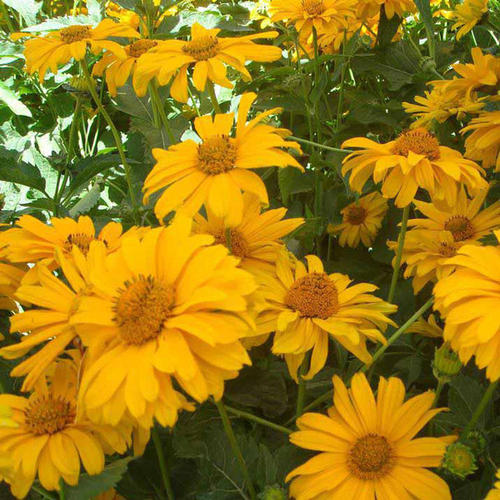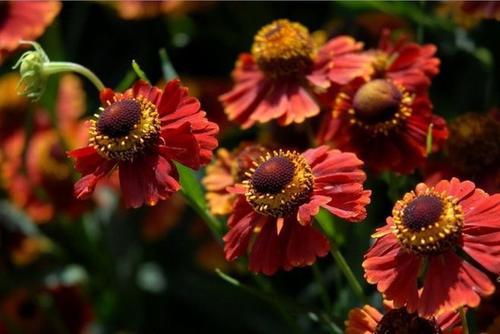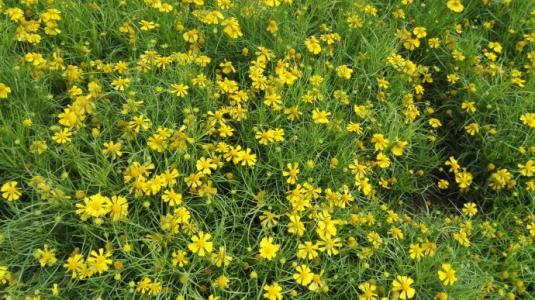Helenium Autumnale (Common Sneezeweed) Profile
Written by Maggie
Dec 13 2022

Common sneezeweed, scientific name Helenium autumnale, has a height of more than 60cm and leaves like the artilanceolate. Helenium Autumnale flowering period can be up to 3 ~ 4 months even in the hot summer. It is a rare flower material for garden planting and container combination planting in hot summer and fall.
Helenium Autumnale Picture

Characteristics of Helenium Autumnale
Helenium Autumnale has broad lanceolate leaves and flower heads at the top of the stem. The tongues have lemon-yellow flowers with broad petals and notch at the apex. The tubular flowers are greenish-yellow & Daisy-Like. (Also Read: 35 Recommended Daisy-Like Flowers for Your Garden In 2023)
The flowering period of Common Rosie zeweed is from summer to autumn and the fruit ripening period is in autumn.
Habits of Helenium Autumnale
Helenium Autumnale likes warm sunny environments, cold resistance and drought tolerance. The optimum growth temperature ranges from 15°C to 28°C. Helenium Autumnale can grow in pastoral soil, sandy loam, slightly alkaline or slightly acidic soil. Sowing and reproduction, generally in sunny beds seedlings, the next spring transplantation, plant row spacing 15×20 cm. Before planting, the land should be turned over and basic fertilizer added, such as bean cakes, sesame paste residue or dried chicken dung. Water once a week during the growing season. Trim the dead leaves of Helenium Autumnale after the flowers have faded to encourage bud formation. common sneezeweed is used for flower bed edges or flower borders in the garden. In recent years, it has been used as ground cover, the effect is very good, the golden leaf is full of vitality. (Find more fall plants here.)
How to Grow & Care for Helenium Autumnale
Helenium Autumnale enjoys abundant sunshine, and it is easy to grow and cae for.Helenium Autumnale Soil Care
The medium was mixed with peat, vermiculite (or perlite) and pastoral soil at a ratio of 1∶1∶1, pH value 5.5 ~ 6.5, and proper NPK slow-release fertilizer was added.
Helenium Autumnale Temperature Care
Suitable temperature is 19℃ ~ 30℃, Common sneezeweed can withstand a high temperature of 35℃, relatively high temperature is conducive to shortening the growth cycle.
Helenium Autumnale Lighting
Helenium Autumnale is happy with sufficient sunshine and long sunshine. The plants grow less than 12 hours and even appear rosette. It is necessary to add light or use a plant growth regulator to break the rosette.
Helenium Autumnale Fertilizer
In addition to the base fertilizer, every week pouring 1 ~ 2 times 200ppm of the whole element compound fertilizer. Common sneezeweed has good branching properties and does not require the use of plant growth regulators. When necessary, 3000-5000ppm B9 can be used to control plant height, which can also help to extend the viewing period.It takes 12 to 14 weeks from sowing to selling.

Helenium Autumnale Propagation
Seedling in a cuppoint dish: peat and vermiculite were collected from the medium, pH value was 5.8-7.0, EC value was less than 0.75 Siemens/cm. The size of hole plate for Common sneezeweed is 400, 288 and 128.After sowing, cover it with vermiculite. The germination temperature is 18°C-22°C, the germination time is 3-5 days, and the growth temperature is 20°C-22°C. Germination does not require light, and the light gradually increased to 1000-30000Lux after the emergence of cotyledon. Maintain air humidity of 90%-95% until it gradually decreases after cotyledons appear. Keep the medium moist until the radicle appears, and gradually reduce the humidity after the radicle penetrates the medium. Fertilizer 50-75ppm15-0-15 was applied after cotyledon appeared, and the concentration of cotyledon was increased to 100-150ppm after cotyledon expansion. It could be applied alternately with 20-10-20, and the EC value of medium was 1.0-1.2 Siemens/cm. Seedling stage of Helenium Autumnale mainly through environmental control and fertilizer and water management to control the plant type, generally do not need to use plant growth regulators. Seedling cycle of Helenium Autumnale is 4-6 weeks.
Distribution of Helenium Autumnale
Native to North America, Helenium Autumnale is distributed throughout the United States and Canada.
Helenium Autumnale Diseases & Pests Care
Common sneezeweed disease is less, occasionally visible powdery mildew disease, lame stem rot. It can be used 65% generation Sen zinc 600-800 times liquid, 50% fast gram spirit 1000-1200 times liquid spray prevention and control. Helenium Autumnale common pests are thrips and aphids, which can be controlled by 1000-1200 times solution of diethoate oxide and imidacloprid respectively.
Helenium Autumnale Uses
Helenium Autumnale in the garden as a flower bed edge or flower layout, for ground effect is also good.

Read Next:
Top 10 Most Beautiful Roses in the World
Top 10 Most Beautiful Flowers in the World
26 Best Autumn Flowers to Plant for Fall Color in Garden.
Top 30 Fall Flowers to Plant - Beautiful Autumn Flowers
30 Fall Plants for a Beautiful Fall Garden
Latest Updated
- Benefits of Bugleweed - 7 Science-backed Health Benefits
- Bugleweed Dangers & Side Effects - Is It Poisonous?
- How to Plant Evergreen Trees - What You Should Know
- When to Plant Evergreens - Grow Guide for Evergreen Trees
- 12 Wonderful Evergreen Shrubs for Your Garden
- 12 Popular Evergreen Plants with Pictures for Beginners
- When And How To Prune A Lilac Bush Like a Pro
- How to Grow & Care for Lilac Vine (Hardenbergia Violacea)
- Japanese Lilac Tree (Syringa Reticulata) Care & Propagation Guide
- Shumard Oak Pros and Cons - What to Know
Popular Articles
- Winter maintenance of Antirrhinum Majus
- How to Grow Terminalia Mantaly Tree
- How to Grow and Care for Crossostephium Chinense
- How to grow Antirrhinum Majus in spring
- Peristeria Elata (Dove Orchid) Profile: Info & Care Guide
- Underwatered Snake Plant (Sansevieria Trifasciata) - Signs And How To Fix
- How to Care for Brazilian Jasmine Plant (Mandevilla Sanderi)
- How to Grow & Care for Graptopetalum Purple Delight in Summer
- Rosa Chinensis (China Rose): Plant Growing & Care Tips
- How to Care for Baby Sun Rose (Aptenia Cordifolia)